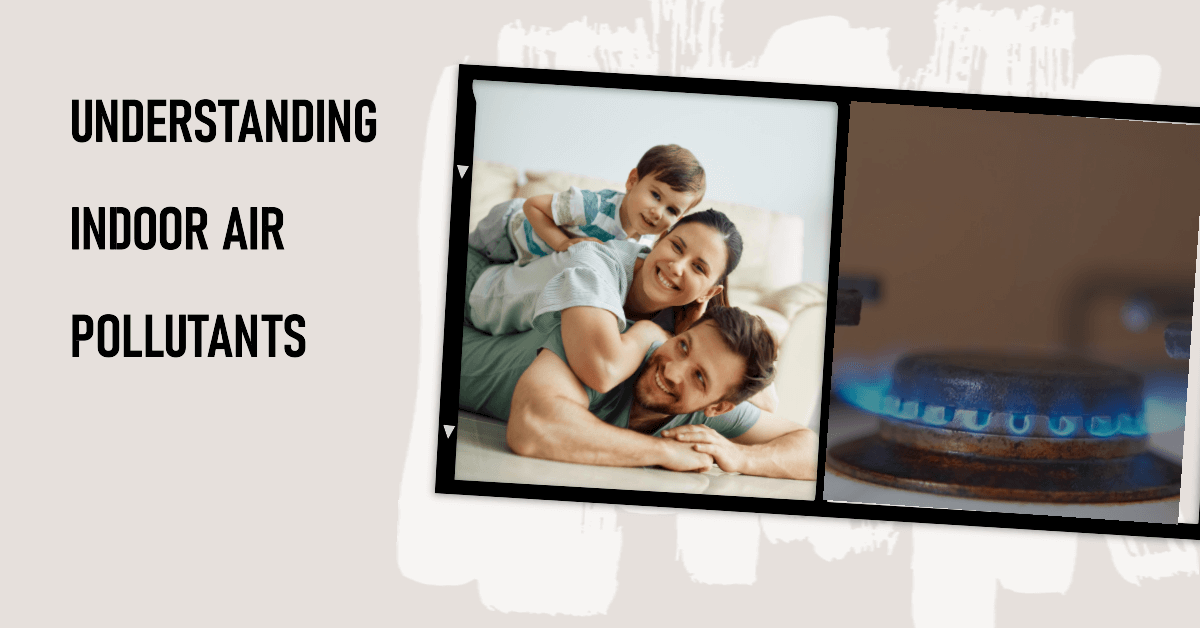Indoor air pollutants is a silent and underestimated threat to our health. As we spend majority of our time indoors, whether at home, work or leisure activities, it’s essential to recognize that the air inside our buildings may not be as safe and clean as it seems. In this article, we will understand about indoor air pollutants, what they are, where they come from, impact on health and how to mitigate their effects.
What Are Indoor Air Pollutants?
Indoor air pollutants are harmful substances found in the air we breathe within enclosed spaces like homes, offices, schools and other indoor environments. These pollutants can originate from various sources, both natural and man-made. Understanding the types of indoor air pollutants is the first step in safeguarding your indoor air quality.
Common Indoor Air Pollutants
- Particulate Matter (PM): Particulate matter consists of tiny particles or droplets in the air that can be inhaled into the lungs. These particles vary in size and composition and may include dust, pollen, pet dander and smoke.
- Volatile Organic Compounds (VOCs): VOCs are chemicals that can easily vaporize into the air. They are released from products like paints, cleaning agents and furniture, contributing to the “new car” or “fresh paint” smell.
- Carbon Monoxide (CO): This colorless, odorless gas can be produced by malfunctioning heating systems, stoves and vehicles in enclosed spaces. It can lead to severe health issues if not detected promptly.
- Radon: Radon is a naturally occurring radioactive gas that can seep into buildings through the ground. Prolonged exposure to radon can increase the risk of lung cancer.
- Mold and Mildew: Moisture-related issues in buildings can lead to the growth of mold and mildew, releasing spores and mycotoxins into the air, which can cause respiratory problems.

Sources of Indoor Air Pollution
Understanding where indoor air pollutants originate is crucial in managing their presence in your living or working environment.
There are several common indoor air pollutants that can compromise the quality of the air we breathe indoors. These include particulate pollution, which consists of tiny particles suspended in the air and household air pollution, which often originates from activities like cooking. Additionally, indoor air quality standards have been established to limit the levels of these contaminants for the safety of occupants.
Here are some common sources:
- Household Products: Cleaning agents, air fresheners and certain personal care products can emit VOCs into the air. Many everyday activities contribute to indoor air pollution, particularly those related to cooking. Gas stoves indoor air pollution can release harmful gases and particulate matter into the air. Being mindful of such contributors and ensuring proper ventilation can help reduce indoor cooking pollution.
- Tobacco Smoke: Smoking indoors releases a slew of harmful chemicals and particulates.
- Building Materials: Some construction materials, like asbestos and lead-based paints, can release hazardous substances over time.
- Cooking and Heating: Gas stoves, fireplaces and poorly maintained heating systems can produce CO.
- Biological Contaminants: These include mold, bacteria and viruses that thrive in damp indoor spaces.
- Furniture and Flooring: Some materials used in furniture and flooring can emit VOCs, particularly when new.
- Pets: Pet dander and fur can be significant allergens in indoor air.

The Impact on Health
Exposure to indoor air pollutants can result in a range of health issues, from mild irritations to severe respiratory problems and chronic diseases. Here’s a closer look at some of the potential health effects:
- Respiratory Problems: Allergies, asthma and bronchitis can worsen due to exposure to pollutants like dust mites, pollen and pet dander. Poor indoor air quality and respiratory problems often go hand in hand. Exposure to indoor air pollutants can exacerbate existing respiratory conditions and lead to symptoms such as coughing and shortness of breath. Maintaining indoor air quality in healthcare facilities is especially crucial to protect vulnerable individuals.
- Headaches and Fatigue: VOCs and CO can cause headaches, dizziness and fatigue when inhaled in high concentrations.
- Cancer: Prolonged exposure to certain indoor pollutants, such as radon, has been linked to an increased risk of lung cancer.
- Aggravation of Existing Health Conditions: Individuals with pre-existing health conditions are more susceptible to the effects of indoor air pollutants.
Understanding the long-term risks associated with indoor air pollution is essential. Indoor air pollution in developing countries can have severe health consequences and addressing these issues is a global concern. Mold-related issues can also affect indoor air quality, making it important to address indoor air pollution mold promptly.
Taking steps to improve indoor air quality can significantly impact your well-being. Breathing cleaner air indoors can help prevent respiratory issues and promote overall health. Strategies to improve air quality in your home include proper ventilation and using indoor air quality management techniques.

The Importance of Monitoring
Indoor air quality monitoring is vital for maintaining a healthy indoor environment. An indoor air quality monitor for home is a device that allows you to assess the levels of contaminants in your indoor air. Regular air quality tests conducted using an air quality meter for home can help you identify and address issues related to indoor air pollutants, ensuring the well-being of your household.
Professional Assessments: For a more comprehensive evaluation of indoor air quality, consider hiring air quality testing companies. These experts can conduct thorough air quality inspections to identify specific issues and recommend effective solutions. If you’re concerned about air quality companies near me, rest assured that professionals are available to assist you.
Ways to Improve Indoor Air Quality
“Good indoor air quality means cleaner and healthier living.”
Ventilation Is Key
Proper ventilation is a very important for improving indoor air quality. Adequate airflow helps dilute and remove indoor air pollutants, such as indoor particulate pollution and household air pollution from cooking. Implementing effective ventilation and indoor air quality solutions can create a healthier indoor environment. Here’s how you can achieve this:
- Open Windows and Doors: Whenever possible, open windows and doors to allow fresh outdoor air to circulate through your home or office.
- Use Exhaust Fans: Use exhaust fans in kitchens and bathrooms to expel moisture and pollutants.
- Air Purifiers: Consider using air purifiers with HEPA filters to remove particles and allergens from the air.
Maintain a Clean Environment
Keeping your indoor spaces clean is crucial for reducing indoor air pollutants. Regular cleaning and maintenance can go a long way in improving air quality:
- Dust and Vacuum: Regularly dust surfaces and vacuum carpets to remove dust, pet dander and allergens.
- Control Humidity: Use dehumidifiers in damp areas to prevent mold and mildew growth.
- Change Filters: Change or clean HVAC system filters regularly to ensure they are not circulating contaminants.

Choose Low-VOC Products
Volatile Organic Compounds (VOCs) are a group of chemicals that can easily vaporize into the air, contributing to high VOC levels in the bedroom and other indoor spaces. When selecting household products and building materials, opt for those with low volatile organic compounds (VOCs). Low-VOC products emit fewer harmful chemicals into the air:
- Paints and Finishes: Look for paints labeled as “low-VOC” or “zero-VOC.”
- Furniture and Flooring: Choose items made from natural or low-VOC materials.
- Cleaning Products: Use environmentally friendly cleaning products that have fewer harsh chemicals.
Understanding the impact of VOC air quality is crucial, as exposure to elevated levels of VOCs can lead to health problems. It’s essential to select low-VOC products and take measures to remove VOCs from indoor air.
Say No to Smoking Indoors
If you or someone in your household smokes, make it a rule to do so outdoors. Smoking indoors releases a multitude of harmful chemicals and particulates into the air, putting everyone at risk.
Test for Radon
Radon indoor air pollution is a significant concern, especially in areas where this radioactive gas naturally occurs. Long-term exposure to radon air pollution can increase the risk of lung cancer. To safeguard your health, it’s essential to be aware of the potential for radon air pollution and take steps to mitigate its presence, such as testing for radon.
Consider testing your home for radon, especially if you live in an area known for elevated radon levels. Radon test kits are readily available and can help you identify if this radioactive gas is present in your indoor air.
Promote Greenery
Houseplants can act as natural air purifiers by absorbing some indoor air pollutants. Certain plants, like snake plants and peace lilies, are particularly effective at removing toxins from the air. They will act like natural indoor air pollutants removers. These indoor air pollution solutions offer eco-friendly ways to enhance air quality.
Air Purifiers:
Air purifiers are essential for maintaining clean and healthy indoor air by removing a wide range of pollutants, allergens, and odors. They help alleviate allergy and asthma symptoms, enhance respiratory health, and reduce the risk of airborne pathogens. Additionally, air purifiers create a more comfortable and pleasant living environment, combat mold growth, and contribute to overall well-being, making them crucial for a healthier home.
It’s important to choose the right type and size of air purifier for your specific needs and room size. Regular maintenance, including filter replacement, is also crucial to ensure the continued effectiveness of the air purifier in reducing indoor air pollutants.
Conclusion: Breathing Easier Indoors
By taking proactive steps to reduce indoor air pollutants and improve air quality, you can create a healthier and more comfortable indoor environment for yourself and your loved ones. From proper ventilation to choosing low-VOC products and maintaining cleanliness, these strategies can make a significant difference in the air you breathe every day.
Remember, your indoor air quality directly impacts your well-being, so don’t underestimate the importance of clean and fresh air in your living spaces. With a little effort and awareness, you can breathe easier indoors and enjoy a higher quality of life.
Frequently Asked Questions (FAQs)
What are the 4 indoor air pollutants?
Four common indoor air pollutants include:
Particulate Matter (PM): Tiny solid or liquid particles in the air.
Volatile Organic Compounds (VOCs): Gases released by various products.
Carbon Monoxide (CO): A colorless, odorless gas from combustion.
Radon: A radioactive gas that can enter homes from the ground.
What are 5 common sources of indoor air pollution?
Common sources of indoor air pollution include:
1) Cooking and heating appliances.
2) Smoking and tobacco products.
3) Household cleaning products.
4) Building materials (e.g., asbestos and formaldehyde).
5) Mold and mildew growth.
What is the #1 indoor air pollutant?
The primary indoor air pollutant depends on various factors, but radon is often considered one of the most significant indoor air pollutants due to its association with lung cancer.
What is the most harmful indoor air pollutant?
While it can vary based on exposure levels and individual sensitivities, asbestos is considered one of the most harmful indoor air pollutants due to its association with severe respiratory diseases.
What are the symptoms of bad air quality in your home?
Symptoms of poor indoor air quality may include:
Coughing and throat irritation,
Headaches,
Fatigue,
Shortness of breath,
Allergic reactions (e.g., sneezing and watery eyes)
What are the 6 major pollutants Clean Air Act?
The Clean Air Act primarily focuses on six major air pollutants, known as “criteria pollutants”:
1) Ground-level Ozone
2) Particulate Matter (PM10 and PM2.5)
3) Carbon Monoxide (CO)
4) Sulfur Dioxide (SO2)
5) Nitrogen Dioxide (NO2)
6) Lead (Pb)
What produces the most indoor air pollution?
Common indoor air pollution sources include activities like cooking, smoking and the use of household cleaning products.
What reduces indoor air pollution?
Strategies to reduce indoor air pollution include improving ventilation, using air purifiers, selecting low-VOC products and addressing sources like smoking or mold.
What causes air pollution inside the house?
Indoor air pollution is caused by various sources, including cooking, heating, smoking, cleaning products, building materials and the presence of mold or mildew.
Is mold an indoor air pollutant?
Yes, mold can be considered an indoor air pollutant. Mold spores can become airborne and affect indoor air quality, potentially causing respiratory issues.
What are three major indoor air pollutants?
Three major indoor air pollutants are:
1) Particulate Matter (PM)
2) Volatile Organic Compounds (VOCs)
3) Carbon Monoxide (CO)
How can I improve the air quality in my room?
You can improve air quality in your room by:
Increasing ventilation.
Using air purifiers with HEPA filters.
Removing or reducing indoor pollution sources.
Keeping the room clean and well-maintained.
Monitoring indoor air quality with devices.
Reducing humidity to prevent mold growth.
How do you test indoor air quality?
Indoor air quality can be tested using various methods, including:Air Quality Monitors: These devices measure various pollutants, such as PM2.5, CO2, VOCs and CO, providing real-time data.
Air Quality Test Kits: DIY kits may include samplers for specific pollutants like radon or mold, which are sent to a lab for analysis.
Professional Assessments: Certified professionals can conduct comprehensive indoor air quality assessments, offering detailed insights.
What is the hardest thing to remove from air?
One of the most challenging pollutants to remove from the air is radon. Radon is a colorless, odorless radioactive gas that can infiltrate indoor spaces from the ground. Mitigating radon often requires specialized ventilation and sealing techniques.
Does staying indoors help air quality?
Staying indoors can help protect you from outdoor air pollutants like smog or pollen. However, indoor air quality can sometimes be worse than outdoor air quality due to pollutants from sources like cooking, cleaning and building materials. Proper ventilation, air purification and managing indoor pollution sources are essential for maintaining good indoor air quality.
DheerajSonwane is a dedicated writer with expertise in air purification technologies. He focuses on providing well-researched content to help readers improve indoor air quality in homes and businesses. As the lead writer at AirPurifierMaster.com, Dheeraj offers practical advice his insightful reviews guide individuals in choosing the best air purifiers for their needs.


4 thoughts on “Understanding Indoor Air Pollutants”